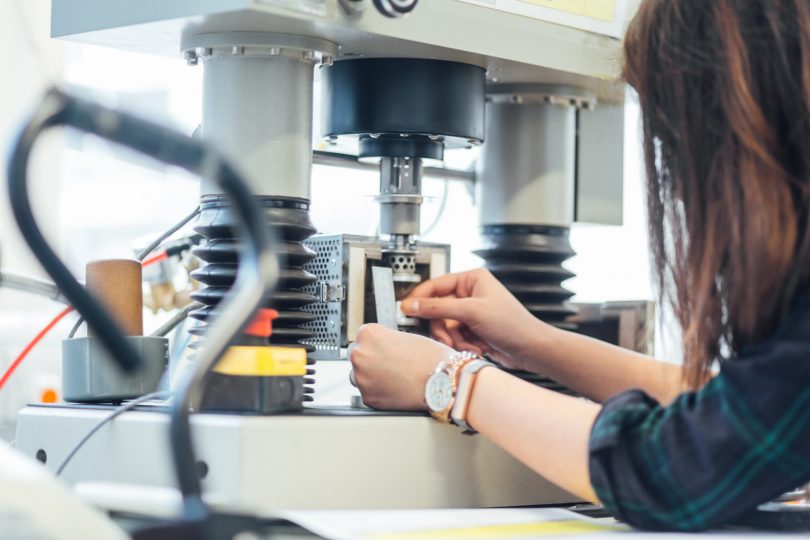Why Material Testing is needed?

Before understanding the difference Between Destructive Testing and Non-Destructive Testing, we must understand Why material testing is needed.
Materials testing can provide a lot of information on the tested materials, prototypes, or product samples for a variety of purposes. Engineers, designers, production managers, and others can benefit much from the data produced during testing and the final test findings.
The following are some of the reasons why material testing is critical:
- Complying with regulatory standards
- Choosing the right materials and treatments for the job
- Assessing product design or enhancement requirements
- Validating a manufacturing process
Materials testing allows us to determine whether certain material or treatment is appropriate for a given application. Testing can assist limit down the choices to the most acceptable material and treatment for the intended use, given the broad variety of materials and treatments available on the market.
In industry, there are two types of material testing procedures: destructive and non-destructive methods.
What is Destructive Testing (DT)?
Destructive testing is a qualitative analysis method for determining material properties such as tensile strength, elongation property, hardness value, and impact toughness, among others.
The qualitative qualities mentioned above are not detectable by NDT procedures. Because the material’s mechanical qualities must be determined by applying load to it. The material deforms as a result of the load, leaving it worthless.
On the other hand, NDT methods are applied in such a way that the material can be reused after testing.
07 Examples of Destructive Testing
- Tensile Test
- Bending Test
- Fracture Test
- Flattening Test
- Hardness Test
- Shear Test
- Impact Testing
DT Test 01 -Tensile Test
One of the most basic and widespread types of mechanical testing is the tensile test, commonly known as a tension test. A tensile test involves applying tensile (pulling) force to material and measuring the reaction of the specimen.
DT Test 02 – Bending Test
The bend test is a simple and low-cost qualitative test that can be performed to determine a material’s ductility and soundness. It’s frequently used as a quality control test for butt-welded joints, thanks to the test pieces and equipment’s simplicity.
DT Test 03 – Fracture Test
The ability of a material to resist the growth or propagation of a pre-existing fault is measured by fracture toughness tests. A fatigue fracture, void, or any other anomaly in the test material could be a flaw or defect. Fracture toughness tests are carried out by machining a test sample with a pre-existing crack and then cyclically applying stresses to each side of the crack to cause it to expand. The cyclic load is applied until the crack in the sample expands. The number of cycles to fracture is kept track of and utilized to assess the fracture development characteristics of the material.
DT Test 04 – Flattening Test
Flattening tests are typically performed on specimens cut from tubular products and involve flattening rings from the tube or pipe between two parallel platens to a specified degree. Tube flattening is a pass/fail test that determines the ductility of a tube after it has been flattened.
DT Test 05 Hardness Test
A hardness test is a technique for determining a material’s hardness. The resistance of a material to persistent indentation is measured in hardness.
There are many methods for measuring hardness, and each of these tests might reveal different hardness levels for the same material. As a result, the hardness test as a procedure might be variable, and the results of each test must be labeled to establish the type of hardness test utilized.
The five most common hardness scales are:
- Rockwell
- Brinell
- Vickers
- Shore
- Knoop
DT Test 06 – Shear Test
Shear testing differs from tensile and compression testing in that the applied forces are parallel to the object’s upper and lower faces. Shear materials behave differently from tension or compression materials, resulting in different strength and stiffness values. Shear testing involves applying a lateral shear force to a specimen until it fails.
Shearing happens on a single surface in single shear shearing and on two surfaces in double shear shearing. When constructing any structures or machine components, understanding shear failure is crucial. The shear force causes the surfaces to become misaligned with one another, causing the material to break.
DT Test 07 – Impact Test
An impact test is used to determine a product’s toughness, or its ability to withstand the energy of shock loading or a dynamic impact. After that, the samples are examined for signs of deformation, fracture, and ruptures using this test procedure.
Izod and Charpy are the two basic forms of impact testing with a pendulum. Both tests are quite similar, however, there are some key differences:
- In Izod impact testing, the sample is held vertically with the notch facing the pendulum
- In Charpy impact testing, the sample is held horizontally with the notch facing away from the pendulum.
What is Non-Destructive Testing (NDT)?
Non-destructive testing is a technique used in industry to examine the properties of a material, component, structure, or system for typical changes, welding defects, and discontinuities without damaging the original part. Non-destructive testing is a sort of non-destructive testing that includes non-destructive examination (NDE), nondestructive inspection (NDI), and non-destructive evaluation (NDE)
07 Examples of Non-Destructive Testing
- Visual Inspection
- Magnetic Particle Testing (MPT)
- Dye Penetrant Testing (DPT)
- Ultrasonic Testing (UT)
- Eddy Current Testing (ECT)
- Acoustic Pulse Reflectometry (APR)
- Radiography Testing(RT)
NDT Test 01– Visual Testing (VT)
Visual testing is a method of analyzing defects that are visible to the naked eye. Inaccessible regions may also benefit from the use of magnifying glasses, video Boroscopes, or mirrors.
NDT Test 02- Magnetic Particle Testing (MPT)
Magnetic Particle Test (MPT) or Magnetic Particle Inspection (MPI) is used to locate faults on the surface and near the surface. The approach is only applicable to ferromagnetic materials (those containing a significant amount of Fe, Co, or Ni), and it is not suited for austenitic steels. It is, nonetheless, an extremely effective crack detection approach.
NDT Test 03- Dye Penetrant Testing (DPT)
DPT is a method for detecting surface defects. It may be used on any material except porous materials and those with an extremely harsh surface finish. The approach employs a high-contrast die that leverages capillary action to penetrate minor imperfections, causing the faults to become evident during the application of dry powder to the surface.
NDT Test 04 – Ultrasonic Testing (UT)
Ultrasonic testing makes use of high-frequency sound waves that are inaudible to humans. The faults are found by analyzing the returned sound waves, which appear on the machine screen as echoes. The approach has a wide range of applications and can be used to discover interior faults in practically any material.
NDT Test 05– Eddy Current testing
To detect faults, Eddy Current employs the principle of electromagnetic induction in conductive materials.
Any discontinuity will produce a shift in the eddy current field, as well as a shift in the phase and amplitude of the recorded signal.
Eddy Current testing is commonly employed in the inspection of surface defects and tubing. These methods were frequently employed in industries such as aerospace and petroleum.
NDT Test 06 – Electromagnetic testing (ET)
The process of producing electric currents or magnetic fields, or both, inside a test object and detecting the electromagnetic response is known as electromagnetic testing. A fault inside the test object produces a measurable response if the test is properly set up.
NDT Test 07 – Radiography Testing (RT)
Radiographic Testing is a non-destructive testing procedure that examines the interior structure of produced components using either x-rays or gamma rays to find any flaws or defects.
The test part is positioned between the radiation source and the film in radiography testing (or detector). Through interaction processes involving scattering and/or absorption, the test-material part’s density and thickness discrepancies will attenuate (i.e. lower) the penetrating radiation.
CONCLUSION
In certain ways, destructive testing is the more reliable procedure when compared to nondestructive testing. Nondestructive testing (NDT) does, however, have a substantial benefit over destructive testing in that it covers more land and saves money on materials.
Analysts can use NDT to avoid harming assets while also discovering more weaknesses in the process. Inspectors must damage viable materials that could have been used during normal operations, making destructive testing more expensive and wasteful.
Furthermore, destructive-means testing is less efficient than NDT in terms of inspection timeframes, requiring manual steps that take longer and demand more work than NDT’s simplified methods.










Sir,
We have 2 ECT at our organisation and we want to improve it capacity. Can you help us?
Awaiting your response.
Rgds
We do not provide this service, but you can check our online courses at http://www.qualityhubindia.com
[…] Destructive testing is a qualitative analysis method for determining material properties such as tensile strength, elongation property, hardness value, and impact toughness, among others. […]